Day 2 of a three day long weekend of tours today. The weather forecast for today was much better – sunshine & showers. We saw some nice sunshine and managed to dodge the showers later in the afternoon. All in all, not a bad day to be out.
As we drove east from our meeting point in Wells, we took a detour inland. A male Marsh Harrier was quartering the field next to the road as we pulled into a convenient layby next to some farm buildings. A quick scan of the roofs and we located a Little Owl in one of its usual spots. It was rather distant today, unfortunately, and there was quite a bit of shimmer already rising from the concrete between us and it. Still, we got an OK view of it through the scope and it was a nice way to start the day.
Continuing on our way east, away from the coast, we turned into a quiet lane and found somewhere to park. A Grey Heron circled over as we set off up the lane. There were lots of warblers singing in the hedgerows here. A Willow Warbler was in full voice high in the bare branches of a tree. A Common Whitethroat sang its scratchy song from the hedge and a Sedge Warbler was rattling away in the damp field beyond. There were several Blackcaps and Chiffchaffs too.
 Grey Heron – circled over the lane this morning
Grey Heron – circled over the lane this morning
As we approached a block of poplars, we could hear a Great Spotted Woodpecker calling and looked round to see it drop out of the trees and down into a clump of sallows in the field. A Green Woodpecker was laughing from the poplars here too. Another Marsh Harrier quartered over the back of the meadow.
Walking on beside the wood, we heard the beautiful sound of a Nightingale singing. It was still some way ahead of us and just singing little snippets at first. As we walked towards the song, a bird flew out of the hedge ahead of us and across the road, flashing an orange-red tail in the morning sunshine. It was a Nightingale, but not the one we could still hear singing in the same place it had been. Nightingales can be rather elusive and we thought that might be the only sight we had of one today, and not everyone had seen it.
We continued towards where the song was coming from and found a convenient gap in the hedge. As we looked over, we could just see a shape perched in the sun – the Nightingale – but it saw us too and dropped straight back into cover. It was in a thicket of brambles and cut branches and for several frustrating minutes we could just see it moving around in the undergrowth as it sang. Then it came out into full view again and perched where we could all see it on a fallen tree trunk.
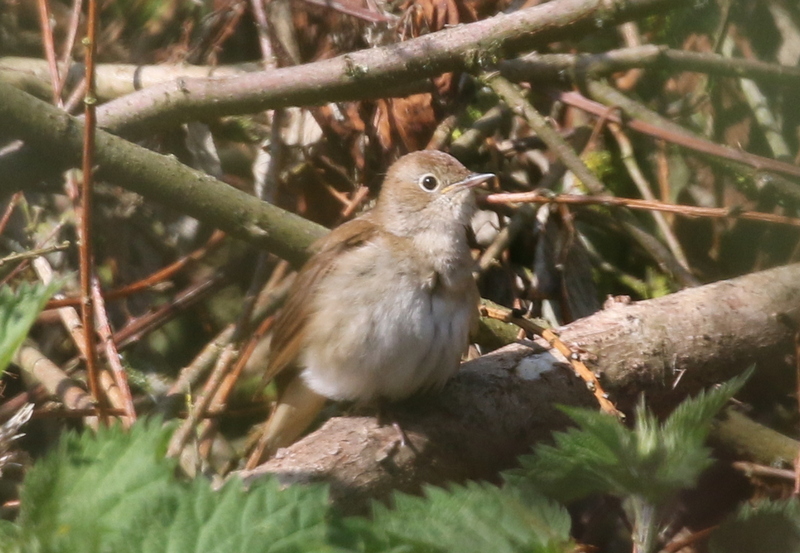 Nightingale – singing and enjoying the morning sunshine
Nightingale – singing and enjoying the morning sunshine
The Nightingale kept hopping down into the thicket but then returned to the fallen tree trunk or a bare branch nearby. We had a great look at it as it perched in the sunshine singing. Eventually, it dropped back into the thicket and we decided to make our way back to the car. As we got back, we could hear another Nightingale singing in the copse next to where we had parked. We stood and listened to that on too, for a few minutes, before tearing ourselves away.
Our next destination was up on the Heath. As soon as we got out of the car, we could hear a Yellowhammer singing. We looked round and quickly located a bright yellow-headed male perched in the top of a yellow-flowered gorse bush. We had a really good look at it through the scope, before it dropped down to the ground beyond.
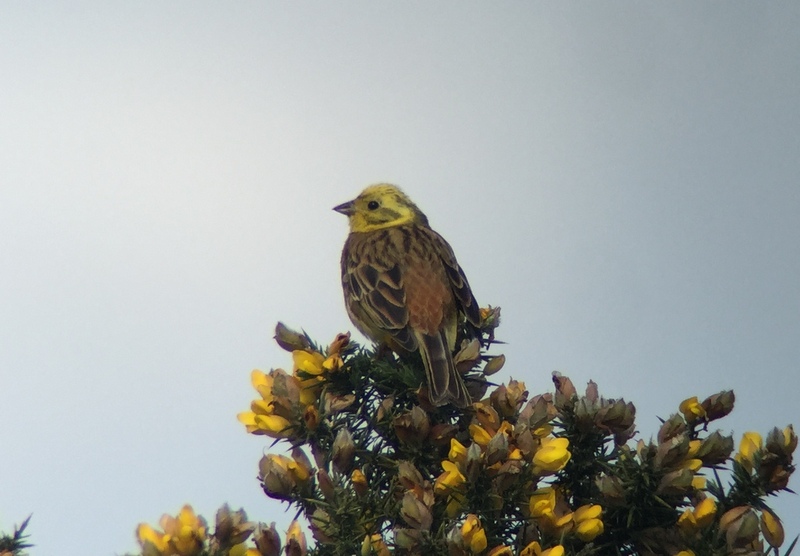 Yellowhammer – a smart yellow-headed male, singing by the car park
Yellowhammer – a smart yellow-headed male, singing by the car park
The Heath was alive with warbler singing too this morning, probably making up for time after the cold and damp weather yesterday. A Blackcap was singing in the trees in the car park. As we walked up the path, we could hear the sweet descending song of a Willow Warbler. A Common Whitethroat was scratching away on top of some brambles. A Chiffchaff was chiffing and chaffing in the birches.
There is no shortage of Linnets on the Heath and everywhere we went we encountered little groups of them, perched in the gorse or up in the trees. Several already had young. Linnet used to be a common farmland bird but sadly they are now much scarcer. Thankfully they still do well in certain places here, particularly on the heaths and the coastal dunes.
 Linnet – still a common bird up on the Heath
Linnet – still a common bird up on the Heath
There was no sound from the Dartford Warblers at the first place we tried, so we made our way round to the other side of the Heath to try our luck there. On our way, a Woodlark flew across and landed on the side of the path ahead of us. We got it in the scope and watched it walking along, picking at the vegetation along the side. It was collecting food for its hungry brood of youngsters somewhere – we could see it already had a caterpillar in its bill.
It was busy on the Heath this morning and a large and noisy group appeared at the other end of the path. The Woodlark ran into the vegetation bordering the path and then flew up and over onto some rough ground beyond. As we walked on towards where it had landed, we could just see it standing on a clod of earth, before it took off. A second Woodlark took off too, it had obviously been collecting food nearby, and the two of them disappeared off over the Heath, calling, just as the large group walked up the path.
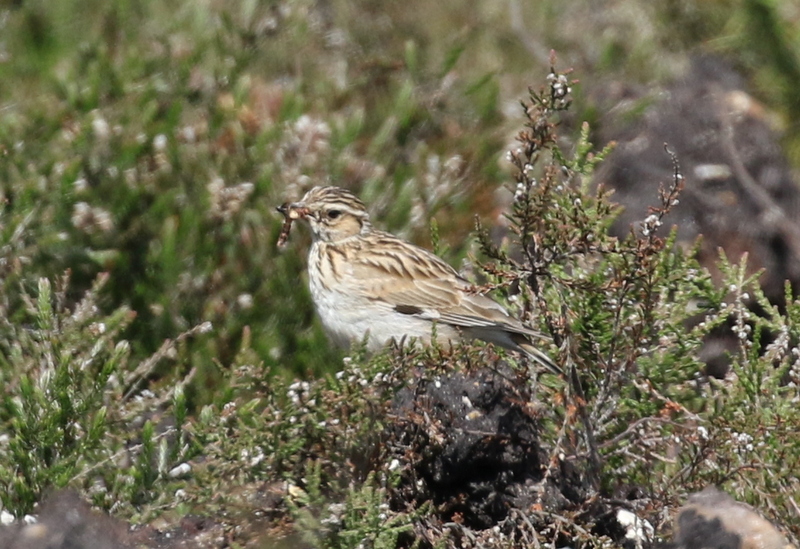 Woodlark – collecting food for its young
Woodlark – collecting food for its young
There were thankfully no crowds of people in the place where we hoped to find the Dartford Warblers today. Unfortunately, at first, there were no Dartford Warblers either! We had to content ourselves with watching a family group of Stonechats – a pair with at least two streaky juveniles. The male Stonechat then appeared on the gorse in front of us and started singing and song-flighting.
Just as we thought our luck might be out, a Dartford Warbler appeared, thought it was too quick as it darted into the gorse nearby. It wasn’t going to give itself up easily, and after a minute or so, we all got a brief view of it as it flew across the path in front of us and disappeared back down into the gorse. We stood staring into the bushes where it had gone but it didn’t come back out.
We really wanted a better view of a Dartford Warbler, and eventually another one appeared on the other side of the path. We tried to follow this one for a while, but again, all we got at first were very frustrating glimpses as it hopped up onto the top of the gorse, saw us, and darted straight back into cover. After we saw it disappear over the bushes a short distance away, we heard it singing. Hurrying along to the corner, we could finally see it, a male Dartford Warbler, picking around in the yellow flowers in the top of a gorse bush. It fed here for a minute or so, before zooming off back past us with something in its bill.
 Dartford Warbler – played hard to get, but finally gave itself up for us
Dartford Warbler – played hard to get, but finally gave itself up for us
There has been an Iberian Chiffchaff at Walsey Hills, near Cley, for the last five days and it was reported to be singing again this morning, so we thought we would just have enough time for a quick visit there before lunch. Iberian Chiffchaff is very similar in appearance to our Common Chiffchaff, but has a very different song (not just a Spanish accent!!), so it was most important to hear it.
However, when we got there nothing had been heard from it for over half an hour. We stayed a few minutes, listening to several Common Chiffchaffs singing away, as well as a Blackcap. It seemed like it had gone quiet, so we reasoned we would be better going for lunch first and having another go afterwards.
 Common Chiffchaff – singing away at Walsey Hills, instead of the Iberian Chiffchaff
Common Chiffchaff – singing away at Walsey Hills, instead of the Iberian Chiffchaff
We ate our lunch at the picnic tables in front of the visitor centre at Cley, a nice place to sit in the sunshine. Then after lunch, we drove back and parked by the East Bank, before walking along to Walsey Hills again. A Tawny Owl hooted from North Foreland wood as we walked in along the path. It turned out it had been the right decision to go for lunch, as the Iberian Chiffchaff had still not been heard again. We had a quick walk through the trees and up round the hill at the back, but we couldn’t hear anything either.
It felt like we were out of luck with this one, so rather than waste too long here, we decided to do something else instead. We walked back past the small crowd waiting patiently by the willows at the back of the trees and up the path towards the road. We were almost out of the trees when we heard the Iberian Chiffchaff singing right by the path.
Unfortunately, it was in a thick clump where we couldn’t see it. The Iberian Chiffchaff sang six or so times in succession – a combination of ‘chiff, chiff, chiff’, ‘hweet, hweet, hweet’ and ‘ti-tu, ti-tu’ and various mixtures thereof, very different from the rather monotonous ‘chiffing’ and ‘chaffing’ of our Common Chiffchaff, then it went silent again, just before everyone the crowd from further back could make it over to where we had found it. We gave it a few minutes, then decided to leave them to it.
A brief light shower passed over, so we collected our coats on the way back past the car, and headed out along the East Bank. A Lapwing was feeding in the wet grass below the bank and several more were displaying further over, the males tumbling and rolling in the sky as they sang their distinctive song. There were several Redshanks down in the wet grass too, and one or two of those were singing and song flighting too. A lone female Ruff was hiding in the grass and a single Ringed Plover was preening on the mud at the back of the Serpentine.
 Lapwing – feeding in the wet grass below the East Bank
Lapwing – feeding in the wet grass below the East Bank
Most of the ducks which had spent the winter here have now departed, but we did manage to find a single drake Wigeon asleep at the back of the Serpentine. A few pairs of Gadwall and Shoveler will presumably be breeding here now. There were also lots of Greylag Geese out on the grazing marshes.
On the other side of the path, a pair of Marsh Harriers circled up over the reedbed. We could hear Reed Warblers and a Sedge Warbler singing from the reeds and got great views of a pair of Reed Warblers as they worked their way along the base of the reeds on the far side of the ditch. A Reed Bunting was singing from one of the bushes in the reeds, although it sounded like it had been rather short-changed in the song department, more like just a brief jumble of discordant notes!
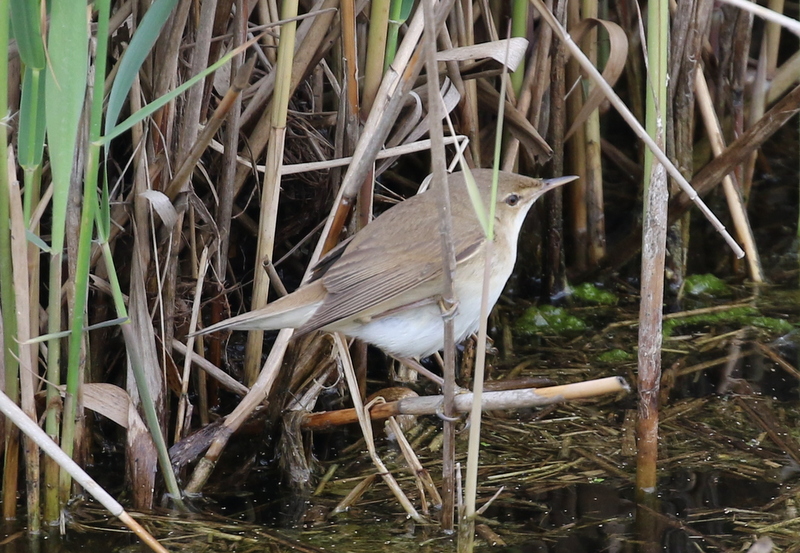 Reed Warbler – a pair were feeding in the base of the reeds by the ditch
Reed Warbler – a pair were feeding in the base of the reeds by the ditch
There were not many waders on Arnold’s Marsh today, apart from Avocets and more Redshank. A pair of Grey Plover over the back were still in winter plumage, in contrast to all the black-bellied birds we had seen yesterday. A pair of Little Terns dropped in to preen on one of the islands and a couple of Sandwich Terns circled overhead calling.
We were on our way to the beach but had just stopped to look at a Meadow Pipit by the path when we heard a Greenshank calling and looked over to see it land in the shallows. We got it in the scope and had a good look at it, but it didn’t stay long and quickly flew off again calling.
When we got to the beach, the sea looked very quiet. A couple of Little Terns flew past just offshore, possibly the ones we had just seen on Arnold’s Marsh. A party of nine Brent Geese flew past, surely heading the wrong way? They should be heading off to Russia for the breeding season. We were just having a quick scan over the water when we spotted a large bird circling some way offshore. An Osprey!
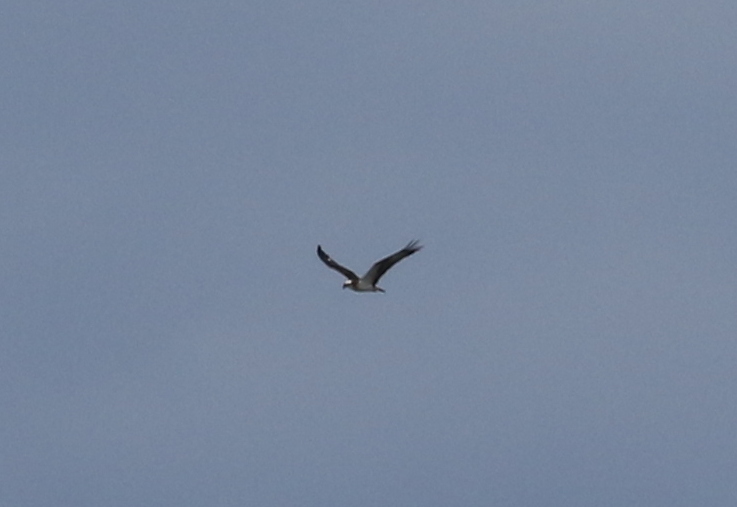 Osprey – a nice surprise find, heading west offshore this afternoon
Osprey – a nice surprise find, heading west offshore this afternoon
It took a while for everyone to get onto it, but the Osprey gradually worked its way a little closer inshore as it drifted past us. At one point, a Sandwich Tern flew up to it and started mobbing it, hastening it on its way. We watched as it headed off west towards Blakeney Point. An unexpected bonus – Ospreys are not common birds here, just passing through in small numbers.
There had been two Temminck’s Stints reported again earlier today on the reserve, but they seemed to have disappeared and everyone we had spoken to said they had not seen them this afternoon, where they had been on Simmond’s Scrape. We had thought it would be worth looking for them on the Serpentine, but they were not there either. As we were walking back towards the car, the news came through that they were on Simmond’s Scrape again so we headed straight round there.
As we walked into the hide, one of the Temminck’s Stints was picking its way around the edge of one of the islands, creeping about. We had a great look at it through the scope, although it was a little distant for photographs. Our smallest regularly occurring wader species, the Temminck’s Stint was completely dwarfed by a Shelduck which walked past it.
A summer plumage male Ruff appeared – a striking bird with jet black throat, breast and down onto the belly, but with bright rufous-ginger head and neck. It flew over and landed on the same island as the Temminck’s Stint, proceeding to chase it out of its way. The Temminck’s Stint looked tiny, even next to the Ruff.
After a while, the Temminck’s Stint took off and flew across the scrape, landing down in the far corner out of view behind the bank. We thought that would be it until someone in the hide pointed to a bird on one of the closer islands a few seconds later. Yes, it was a Temminck’s Stint, but this was a different one, the second bird. It was much closer to us and we got a great look at this one, much less well marked with black-based summer feathers than the first Temminck’s Stint we had been watching.
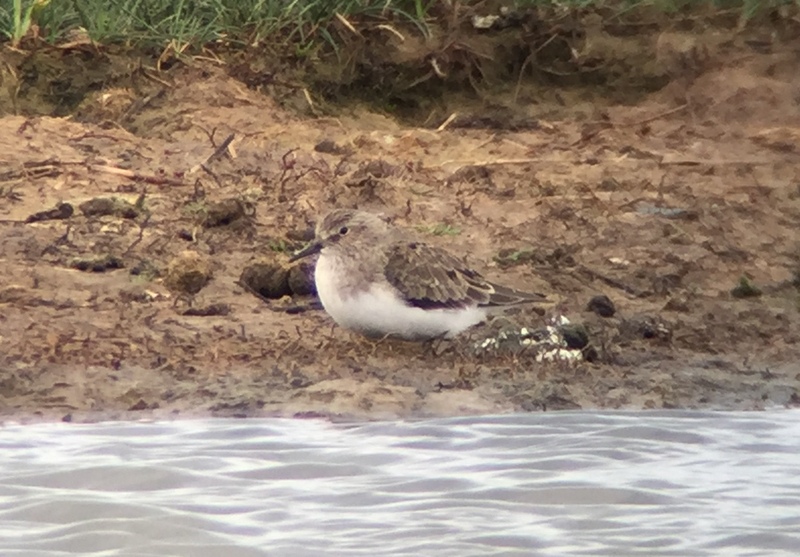 Temminck’s Stint – the second one, less well-marked, greyer, than the first
Temminck’s Stint – the second one, less well-marked, greyer, than the first
At this point it started to rain, so we stayed in the dry in the hide and had a scan of the scrapes. There were lots of Shelduck and Avocet on here today, but not much else of note. We could hear a Cuckoo calling in the distance. A Little Egret walked out of the ditch in front of the hide, ran across to the edge of the scrape, but then changed its mind and flew across to the far side of the ditch. A pair of Pied Wagtails were feeding on the edge of the water, and perching on the posts in front of the hide.
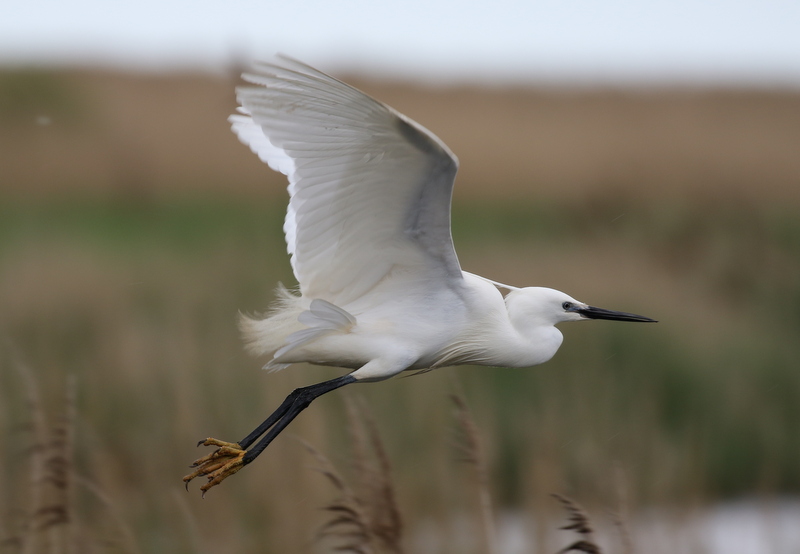 Little Egret – in front of Dauke’s Hide this afternoon
Little Egret – in front of Dauke’s Hide this afternoon
The shower didn’t last long, but once it cleared it was time to head back to the car and home.
















